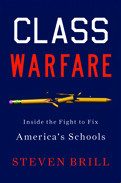
Class Warfare: Inside the Fight to Fix America’s Schools
Steven Brill
496 pages, Simon & Schuster, 2011
Consider this Twitter message from Save Our Schools, a group opposed to the Obama administration’s education reforms, about Class Warfare: “Worst part of Brill’s new book: Everyone’s buying a copy.”
It’s noteworthy when a serious book about education reform makes it onto the bestseller list. Class Warfare weighs in at nearly 500 pages, almost a quarter of it devoted to sources and references. Chapters end on wonk-friendly cliff hangers: “It seemed that private foundation investments were actually going to bring change. Could investments by a government bureaucracy also produce results?” Class Warfare is selling because it’s a good read, presenting the struggle to reform American schooling as a heroic tale populated by real people. But it also poses some juicy innovation questions.
Brill got interested in education while writing a scathing New Yorker article about “rubber rooms”—holding tanks where New York City teachers suspected of wrongdoing whiled away years at full pay. In doing so, he waded into the hottest debate in education. On one side are “reformers,” who believe that the quality of teaching makes a huge difference in life outcomes for kids and that school systems need to be a lot better at getting good teachers into classrooms and bad ones out. On the other side are those, often associated with teachers unions, who see the role of schools as overshadowed by poverty and other social ills and who see the effort to measure teachers’ and schools’ performance as an excessive faith in testing.
Brill makes no secret of which side he’s on. In his two-year exploration of education, he found voluminous evidence that good teaching matters and argues we need to act urgently on that knowledge. He admires the leaders of the reform movement, from Jon Schnur, co-founder of New Leaders for New Schools, to former Washington, D.C., schools chancellor Michelle Rhee, whose stories he tells in humanizing detail. (Disclosures: my firm supports many of the pro-reform organizations named in the book.) The reformers stand against school districts—“the most lavishly funded and entrenched bureaucracies in America,” he writes—and against teachers unions with “money and playbooks every bit as effective in thwarting the public interest as Big Oil, the NRA, or Big Tobacco.”
Readers can sense Brill’s wonderment at education’s hall-of-mirrors politics. It is the teachers’ own unions that have fought to treat them as a mass differentiated only by years of experience and academic degrees. And it is the left that defends gradualism, arguing that there’s not much that schools can do about poverty. Meanwhile, the right pushes for radical institutional change and for judging school systems by how well they serve poor and minority children. The situation leaves Brill’s heroes, mostly youngish Democrats including candidate Barack Obama, asking, essentially, “Dude, where’s my party?”
Brill’s tale offers Bob Woodward-style close-ups as the nascent Obama administration grabs the reform baton and enacts Race to the Top, a competition that encourages state-based reforms. Yet the focus of reviewer fascination is Brill’s final chapter, where he concludes that reform can’t happen at meaningful scale without the teachers unions. Some have misunderstood Brill’s coda as a repudiation of the previous 400 pages.
So why the last chapter? Brill has said that he was touched, late in the reporting process, by a few incidents that dramatically demonstrated how hard it will be for successful reforms to reach wider scale. Most poignant is the story of Jessica Reid, a teacher in a high-performing Harlem charter school whom Brill follows throughout the book, who quits over fears that the pace of her work is threatening her health and her marriage. Meanwhile, KIPP’s Dave Levin worries about what it would take to give excellent training and leadership to the country’s 3 million teachers. And so Brill arrives at the fundamental social innovation quandary: What will it take to go from islands of excellence to systems of excellence?
Brill ticks off a handful of solutions: paying more in salary to early-career teachers and less for seniority and extra academic degrees; eliminating “last-in-first-out” policies that target recently hired teachers for layoffs; and spending new money to boost teacher salaries. All of these are right, but we’ll need to do much more. We need to do far better at connecting teacher preparation with what teachers actually do in the classroom. We need to ramp up the use of technology that helps teachers tailor instruction to students’ needs and makes better use of teachers’ time. We need broader measures of student learning than today’s standardized tests. We need to get better at recognizing, and reacting to, both strong and weak teacher performance. And we need to get beyond our hall-of-mirrors politics, so that recognizing the impact of teachers can no longer be framed as an attack on them.
Jonathan Schorr is a partner at NewSchools Venture Fund, a nonprofit venture philanthropy firm that supports innovation in education.

